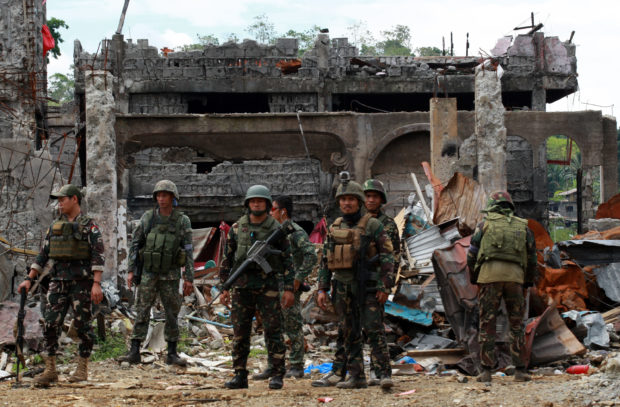
NEARING END Soldiers on the front line in the war against Islamic State-inspired terrorists in Marawi City are happy about reports from their superiors that the crisis is ending soon. —JEOFFREY MAITEM
Islamic State (IS)-inspired terrorists holed up in Marawi are resisting government security forces tenaciously, but the military is on its way to liberating the city and rescuing the remaining hostages, Malacañang said on Thursday.
Troops rescued 17 more hostages, while eight terrorists have surrendered and turned over nine hostages to the military.
“We see this as a positive development toward the liberation of Marawi from the hands of terrorists,” presidential spokesperson Ernesto Abella said.
Abella said the remaining terrorists from the Maute and Abu Sayyaf groups holed up in a small pocket of Marawi seemed determined to fight to the end.
Government troops, however, are focused on rescuing the remaining hostages, he said.
Abella referred to the terrorists who had pledged allegiance to the IS jihadist group in the Middle East as “rebels” and their attack on Marawi to establish an IS enclave in Southeast Asia as “rebellion.”
“While rebels remain holed up in a small portion of the city, they show tenacity and resistance,” he said.
“Military operations are focused and intense and necessitate time to rescue remaining hostages, and bring to a decisive conclusion the Marawi rebellion,” he added.
The battle for control of Marawi has gone on for more than four months.
More than 900 people have died in the fighting, including 753 terrorists, 155 soldiers and police, and 47 civilians.
Terror leaders still alive
The leaders of the terrorists—Abu Sayyaf commander Isnilon Hapilon and Maute group chieftain Omarkhayam Maute—are still in the battle zone, according to the military.
“We talked to one of the [rescued] hostages and he
confirmed that Hapilon and Omar were still alive and inside,” said Col. Romeo Brawner, deputy commander of Joint Task Force Ranao.
He said the rescued hostages were in good health, except for one who had injuries and had to be taken to hospital.
Brawner said the military was interviewing the former hostages, especially the men, to determine if they had been involved in fighting.
“Maybe they fought along with the [terrorists], but we have to know for sure. We have a process that we follow,” he said.
Bombs found
On Wednesday afternoon, Brawner said the troops recovered nine improvised bombs and 20 blasting caps in a house in Matampay village that was used by the terrorists as a bomb-making factory.
“Our soldiers were in the process of cleaning the village in preparation for the end of the war when they discovered these [improvised bombs] in a plastic drum,” Brawner said.
Brawner could not say when the fighting would end.
He said the three-day time frame mentioned by officials in Manila was just an estimate.
While the terrorists were cornered in a small part of the city, he said, the troops could not launch a make-or-break assault because it could endanger the lives of the remaining hostages.
Forty unidentified bodies recovered from the battle zone were buried in the public cemetery on Thursday.
Anir Mindalano, chief of Marawi’s disaster risk management office, told reporters that going by the bullet wounds on the bodies, 80 percent of those buried were terrorists.
Mindalano said the bodies were retrieved from the war zone and no one came to claim the remains.
He said his group would exhume the body of a Marine who was buried in the cemetery.
The Marine was Pfc. Alejandro Balian, who was identified through DNA match with a member of his family, Mindalano said.

